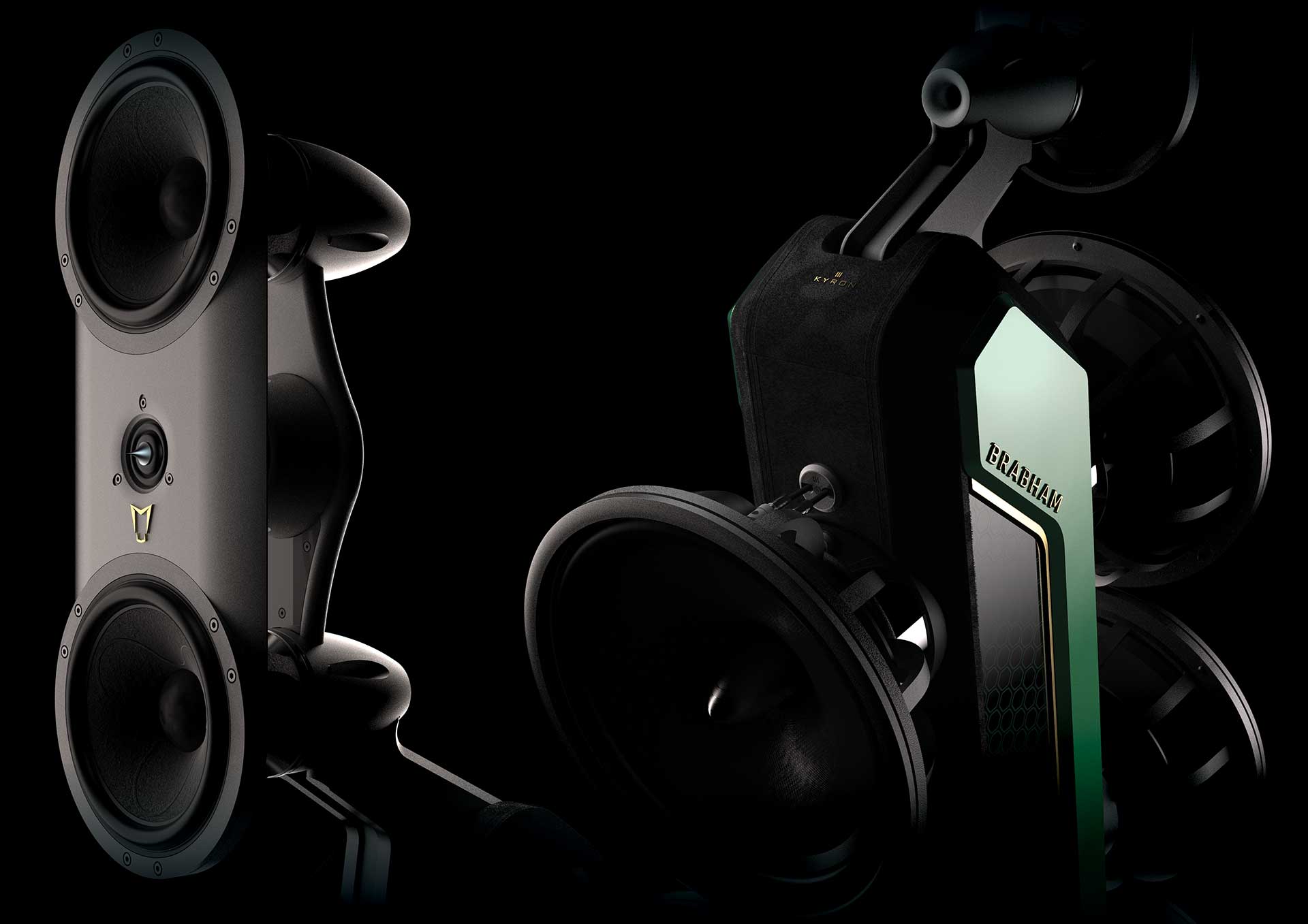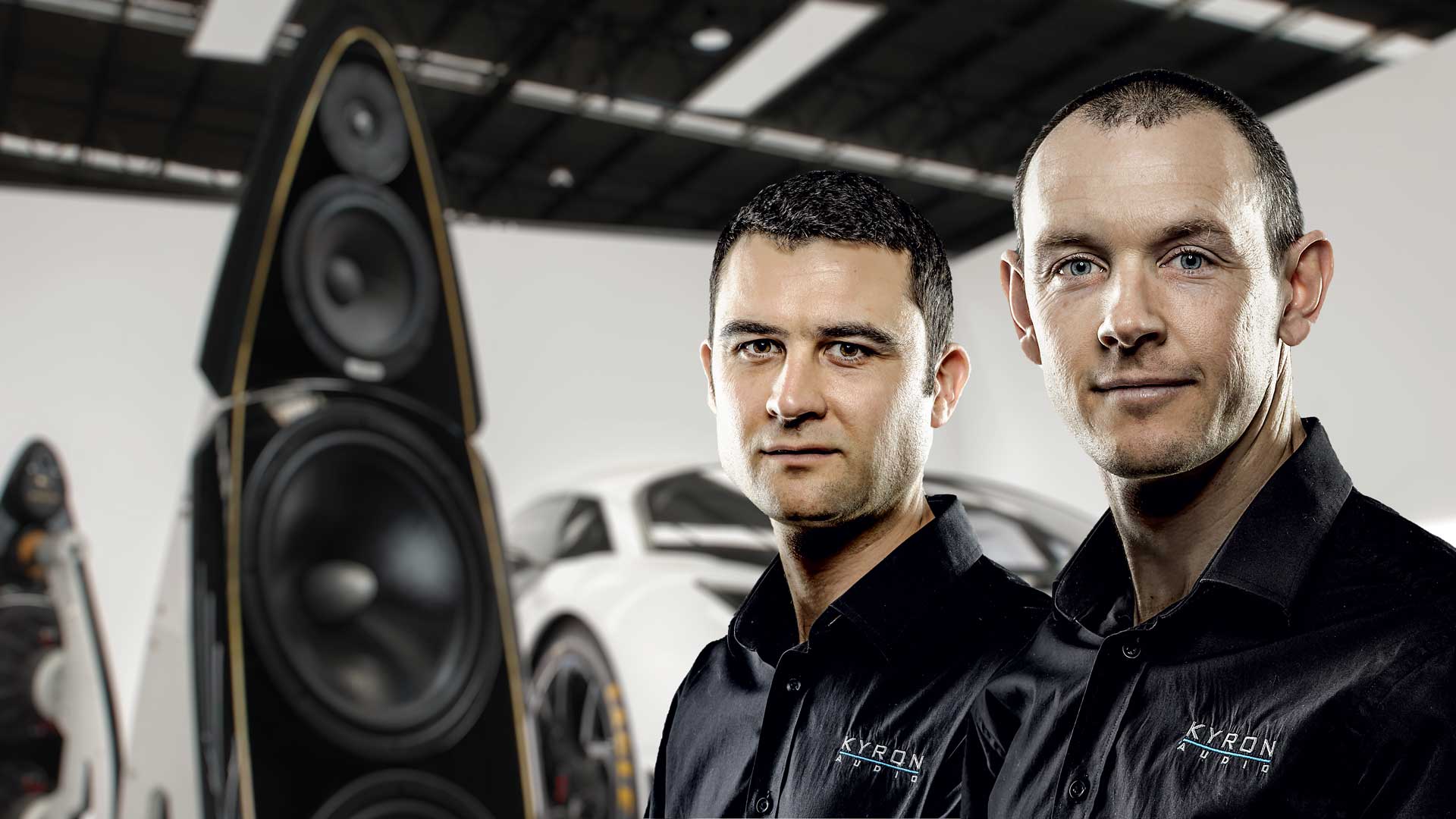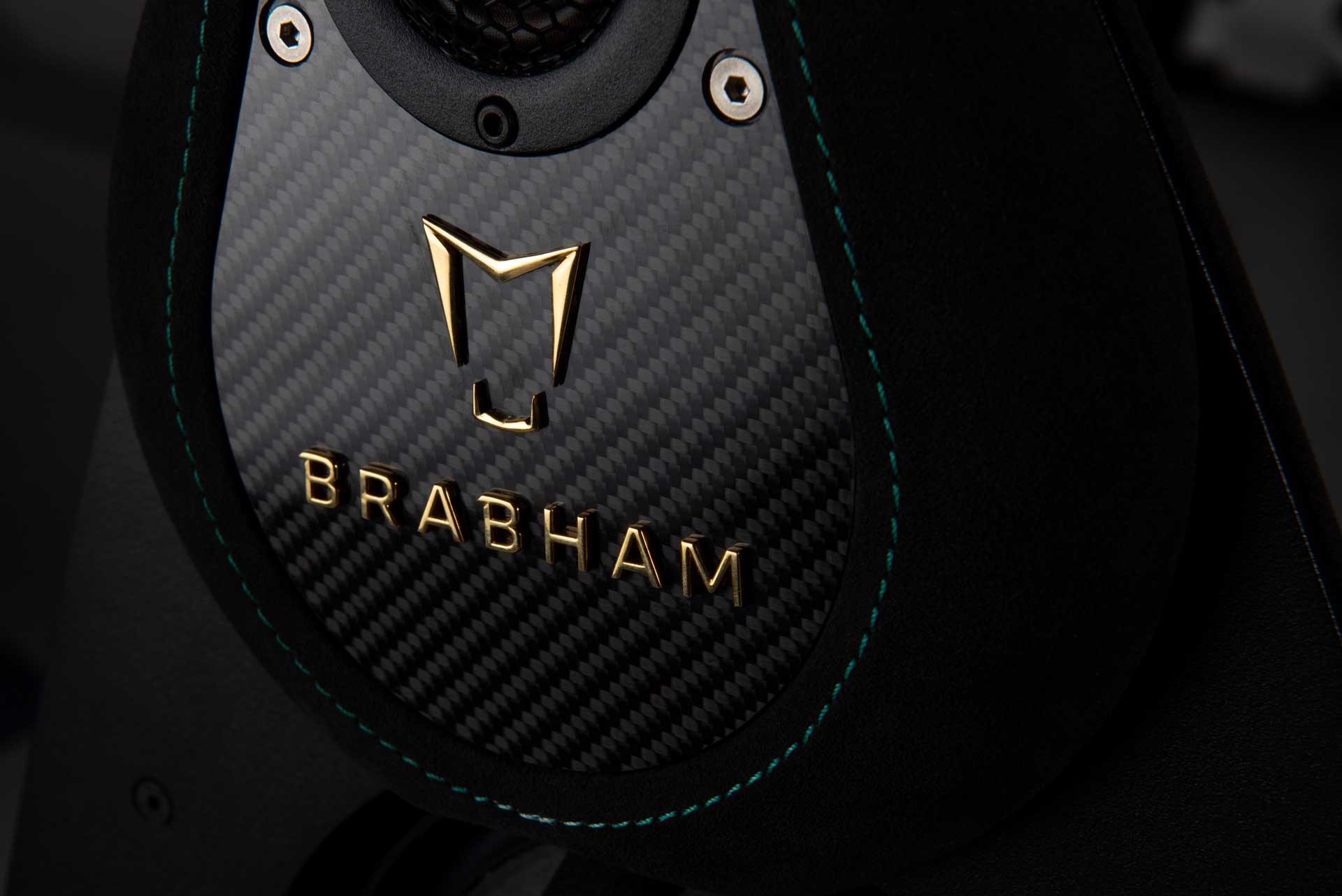A supercar to match your super-hi-fi: all from South Australia's supertech cluster
Kyron teams up with Brabham Automotive for the ultimate Special Edition audio systems

Brabham Automotive’s BT62 has been called the world’s most track-focused hypercar. Tubular spaceframe steel chassis; naturally aspirated 5.4-litre V8. Only 70 BT62 cars will be produced, built in Australia by a team led by British-born Australian racing driver David Brabham.
David is the son of Sir Jack, the only man to win a Formula 1 world championship driving a car of his own construction, three-time F1 world champion, and founder of the Brabham racing team that went on to win 35 F1 races.
And in a newly-announced partnership, Kyron audio systems are now available for Brabham Automotive customers to order in liveries matching their BT62. It’s part of a Kyron bespoke production program that will also see Kyron developing audio systems for future Brabham road-based vehicles.
"Brabham is pushing the envelope in car design, driven to develop the world’s best hypercar," says Lee Gray of Kyron. "The partnership makes sense as we share the same passion for extreme performance in our respective fields."
"Most prestige motor manufacturers have aligned with high-end audio companies, and currently we are designing the audio for the street-legal version of the BT-62. In the near future we’ll start work on an audio system for their planned road car."

Passion for extreme performance is right. Kyron has carved its position at the highest levels of audio performance, with systems that combine unique box-less dipole design with unparalleled realism in performance.
First came the statement Gaia system, currently priced at AU$289,000 (about £158,000), and then the Kronos (AU$161,000 / about £88,000 with its optional subwoofer). And finally the flagship AU$349,000 (about £191,000) Phoenix system, with seven different elements and twice the processing power of Kronos.
The latest hi-fi, home cinema and tech news, reviews, buying advice and deals, direct to your inbox.
"Brabham customers will be afforded the opportunity to purchase a bespoke 'Brabham Signature' version of a Kyron system matched to the livery of their car," explains Gray.
"We will use the same rotary touch-screen interface in both the car and the home system so there is a seamless transition between the two. There will also be aesthetic enhancements such as carbon-fibre detailing, gold pinstriping, leathers, and of course they will sport the Brabham and Kyron badges."
As for Brabham Automotive, CEO Dan Marks explains their side of the equation: "Brabham partners with brands which have the same focus on quality, customer engagement and which strive for excellence in their field."
"Kyron, a fellow Adelaide-based [South Australian] company, fits that mould, making a premier product for the world stage. Kyron’s dedication to design, engineering and performance matches our own, offering Brabham customers an outstanding lifestyle choice."

Kyron V2 stealth development
The Brabham connection is not the only news from Kyron, which has been in ‘stealth design mode’ for nearly two years. "We have been working excruciatingly hard on developing new versions of all our products, codenamed V2 – so a new Kronos, new Gaia and the flagship Phoenix," explains Leon Suter, the 'sound technology' guy at Kyron [see interview below].
"We have made quite extensive changes to improve performance in every area, as well as the visual design and user interface. This has been a massive project... improving what many regard as the best sound available anywhere across three separate systems. The first of the V2 Gaia and Phoenix are in their final stages of assembly and will go to their new homes very soon."
All Kyron speakers are systems, incorporating amplification, cabling and control, rather than being just speakers. Yet in a high-end environment, mix-and-matching separate components is often part of the process.
Have they had any pushback against their system approach?
"We had a desperate desire to create the best sound possible," explains Suter. "The case for designing a complete system is so water-tight that we felt we simply had to go that way. All but the most budget studio monitors and pro audio speaker systems are designed this way too."
"We certainly understand that for many audiophiles there are emotional and budgetary reasons that make switching out a whole system very difficult. But we’ve also witnessed the joy and relief that comes from knowing that tweaking is not needed, required, or missed, and the ongoing feeling of dissatisfaction is completely eradicated. Music becomes the focus – as it should be!"
As for the preference for box-less dipole designs, Suter’s response is brief. "It sounds so much more like real music!," he exclaims. Lee Gray continues: "One of the biggest failings we found with conventional speakers was the enclosure resonance."
"Just talking into your cupped hands gives you a crude example of what is going on inside a speaker box. You can address that to some degree, but a dipole design eliminates it."
"But while in theory it sounds very simple to build a speaker without a box, in reality it’s quite the opposite, especially if you are driven to deliver a state-of-the-art product. How do you make the frame inert? How do you hold the drivers? How do you elegantly conceal the cabling? And there are no ‘B’ surfaces, so everything is exposed and everything must be critically considered."
"But the initial dipole prototype we built was the first time I heard a concert bass drum on a hi-fi system that just sounded right, " says Gray.
"It wasn’t the muffled boom I’d been used to hearing from sealed and ported designs. It was a drum with calf heads, hit with a felt mallet! Vocals were cleaner and more true-to-life, string instruments were no longer coloured. It was a long, difficult road to bring a dipole system to reality, but from that point on it was a no-brainer for us to ditch the box."

Looking the part
Kyron’s systems look like nothing else in audio, the designs extraordinary, with material choices of the highest calibre. How did they end up so different to everything else, and how hard is it to make a design reality after they have a look in mind?
"When we started this nearly 20 years ago, we had no ties into the audio industry, and I never used other speakers as a reference for my designs," explained Gray. "At the time very few companies were doing dipole speakers, so we stripped everything back to first principles."
As for the space-age designs, we can thank Gray’s love of sci-fi and addiction to Hans Zimmer.
"Spotify just sent me notification that I am in the top one per cent of Hans Zimmer fans!" he laughs. "I listen to a great deal of him when I’m designing; I find it perfect for keeping me energised and in the flow. It seeps into the design. Then turning these products into reality is just very hard meticulous work from everyone involved."
"3D printing has been a liberating thing that in recent years has allowed me to realise some of my more radical designs. We now use 3D printing for a number of production parts – the machine we use is one of only two in the country and is worth AU$750k [about £410,000]."
"Some of these parts are over AU$1k [about £550] each but tooling with conventional methods would cost many hundreds of thousands to achieve the same result." He praises Kyron’s suppliers and employees, "who truly care and are driven to be the best at what they do."
"Education, documentation and quality control are the key, though. One example: For the latest soon-to-be-released version of Gaia we compiled a document of 150 pages for the machining alone."

Interview
Leon Suter is the sound technology guy, Lee Gray is the designer and mechanic, and both are musicians. Jez Ford asked how their paths led to Kyron and how they work together.
LEON SUTER: "Lee definitely takes care of the mechanical side, with my input mostly confined to anything that may affect the acoustic performance of the design. I have always had a passion for sound."
"I often used to call in to the only hi-fi shop in town on my way home from school, checking out everything in the store. I remember feeling betrayed beyond belief as a teenager when my father went shopping with my uncle for a new hi-fi system without my knowledge!
"I went on to study classical clarinet at university and chose to also study advanced mathematics and numerical computing. I continued this dual passion when I joined the Air Force as a clarinettist and was the studio and live sound engineer."
LEE GRAY: "Yes, I’m the nuts and bolts guy, and I leave the bulk of the electronics to Leon, along with all those other fun things like accounts. I was very lucky growing up – I had full access to the tools in dad’s shed, and I may or may not have had a secret desire to be MacGyver! I’ve had a split career as percussionist and now an industrial designer, which positions me well for this crazy world of speaker design."
LS: "Kyron officially began way back in April of 2001. Lee and I were musicians in the RAAF at the time and I found that Lee was quite good at woodwork and, generally, at building stuff. We initially intended to build two pairs of speakers, one for me and one for Lee."
"We were very confident that our skill sets would allow us to build something that would exceed what we could buy commercially for the same amount of money. In typical Kyron fashion, we did a lot of research and put a pile of engineering into our two-way MTM floorstanders."
"Our mates found out about what we were doing and soon we were building five pairs. They turned out extremely well, and all of those pairs are still being used today. Lee has his in our design office and mine are in my living room. I’m particularly proud of the piano black finish I managed to achieve too. It’s nothing like the concourse finish we have now, but it still looks great some 18 years later."
LG: In recent times, though, we have been fortunate enough to expand our team with other talented designers and engineers, which has pushed us even further. And in the course of running a loudspeaker company, I’ve found myself doing things I’d never have expected."
"Recently I have added ‘interviewer’ to my CV. With our new website we’ll be launching a series of videos showcasing professional musicians. We discuss their life and their music and listen to a few of their favourite tracks in our experience room. It’s been great fun and I hope it will become a strong platform for promoting artists."

Kronos plus Halcro
The Kronos was Kyron’s second system, designed to be more affordable than the Gaia. And yet one of Kyron’s mottos is ‘No compromise’. So how did they reconcile ‘more affordable’ with ‘no compromise’?
"Life is full of constraints,’" admits Leon Suter. "But 'no compromise' for us is more about how we approach each decision we make. Kronos was designed to integrate with certain living spaces in a way that Gaia is not able to, but our brief was not about where we could cut back on quality, rather how we might deliver the same quality within a certain level of capability and a different aesthetic appeal."
Praised for its aesthetics, awarded a Sydney Design Award and a Melbourne Design Award, as well as winning multiple awards for its sonic performance, the Kronos sports two Scan-Speak ring radiator tweeters, one firing forwards, the other firing to the rear.
Below them sits a 165mm Scan-Speak Illuminator midrange driver, while the much larger lower baffle houses twin Acoustic Elegance 12-inch drivers. The amplification supplied in the Kronos system is Hypex nCore, but at hi-fi shows, Kyron is demonstrating the Kronos with Halcro amplification. Is this a sign of things to come?
"The Halcro amplifier design is very, very special, and is also designed and made in Adelaide," enthuses Suter. "Adding six channels of Halcro Eclipse amplifiers adds nearly AU$400,000 [about £219,000] to the price of a Kronos system, and the improvement is not subtle."
"We are working with Halcro to develop special editions of our systems that will have Halcro Eclipse amplifiers. At hi-fi shows we also have a Döhmann Helix turntable, another incredible Australian product, as a source. We may not have the scale or budget of the huge international audio companies but we have each developed products that are class-leading."
"Back in the early 2000s when we were just starting, I looked to the success of Halcro as inspiration," adds Lee Gray. "We did reach out to them when we were looking for amplification for Gaia 1 around 2008 , but that was right at the end of their first chapter. Now they are back, it simply makes sense for us to work together and hang out in the same bars. No better way to talk about hi-fi than over a glass of SA red!"

And now another South Australian connection, with Kyron working on the audio systems for Brabham Automotive. And beyond the music, the Kyron team has had input into the cars themselves.
"We’re there to advise them on all their acoustic needs," says Lee Gray. "Leon recently assisted them in the modelling of an exhaust system for the BT-62 to ensure it met strict SPL requirements for the track."
"This is a new adventure for us into a slightly different field, but as we have tackled everything from room acoustics and active dipole design to defence simulators, we are up for the challenge!"
"And, as Leon has said, the last two years have been a very intense time of development. I am very excited about sharing these new products with the world as these are by far the greatest things we have ever created. So this year is about more music and more fun!"
Leon Suter concurs on what gives the Kyron team the most pleasure. "There are those special musical moments when you get a system perfectly tuned to its environment, turn the lights down and press play on a really killer track," he says.
"I have great pride and satisfaction knowing the level of performance and quality we have been able to achieve with our products, and seeing the joy our products bring to our customers."
Sound+Image is Australia's no.1 mag for audio & AV – sister magazine to Australian Hi-Fi and to the UK's What Hi-Fi?, and bestower of the annual Sound+Image Awards, which since 1989 have recognised the year's best hi-fi and home cinema products and installations. While Sound+Image lives here online as part of our group, our true nature is best revealed in the print magazines and digital issues, which curate unique collections of content each issue under the Editorship of Jez Ford, in a celebration of the joys that real hi-fi and high-quality AV can bring. Enjoy essential reviews of the most exciting new gear, features on Australia's best home cinemas, advice on how to find your sound, and our full Buying Guide based on all our current and past award-winners, all wrapped up with the latest news and editorial ponderings. Click here for more information about Sound+Image, including links to buy individual digital editions and details on how best to subscribe.

